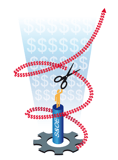Supply Chain Execution 101
Brian Hoey - September 15, 2020

In Gartner’s Hype Cycle for Supply Chain Execution Technologies, supply chain players can get a sense of how the transportation and order fulfillment landscapes are changing as a result of new and emerging technologies—from blockchain and digital twins to transportation forecasting and last-mile delivery solutions. For each technology, Gartner plots out how far along the hype journey we are, from the inflated expectations of the early days to the sustained productivity of mature technology, along with how much time they expect each new paradigm to need before it reaches maturity.
This is a great primer on how supply chain execution stands to change in the coming years (hint: it will be increasingly digitized and connected with other touchpoints), but it’s also a real reminder of just how difficult execution can be in an increasingly volatile market. After all, if turning supply chain plans into successful product deliveries were easy, we certainly wouldn’t need things like autonomous mobile robots and 5G trucking networks to get goods from Point A to Point B. Especially in the midst of the COVID-19 crisis, simply securing the lane- and mode-specific transport capacities at a favorable price has become a herculean task.
All of this raises the question: when it comes to the execution process, what tactics and technologies can really make a difference for supply chain businesses who are hoping to remain competitive in the global marketplace?
Execution in a Volatile Supply Chain
Historically, shippers and others have thought of execution in terms of a fairly short window of time—confining their planning activities to the one to five days that it actually takes to fulfill an order successfully. Thus, once the orders had actually materialized, shippers would find and select the best transport options. In the past, this was more or less logical, since it was difficult to predict in advance what future shipping prices and capacities would be like; sometimes you would pay higher prices than anticipated, but this was accepted as the cost of doing business.
If anything, prices and capacities have become even more volatile in recent years—in keeping with increased volatility in customer demand and other key drivers of the value chain. But while planners have increasingly turned to modern, digital planning solutions that help them sense customer demand and plan accordingly, execution largely hasn’t followed suit. The result is a supply chain where production runs are optimized for cost and efficiency based on advanced predictive analytics and smarter, connected planning solutions, while the actual execution of orders following those production runs is subject to uncertainty that threatens to wipe out any cost advantage gained in the production phase. This gap between planning and execution is obviously not tenable in the long term—which means that supply chains need a way to expand the planning horizon for execution, such that they can more effectively secure the right transports at the right costs.
The Power of Transportation Forecasting
Of course, even within a limited planning horizon, there’s plenty of tactics you can use to improve execution costs: bundling shipments, utilizing backhauls, exploring production-in-the-truck workflows, etc. But without a long view of the process, these improvements can be neutralized by daily fluctuations in price and capacity. Thus, shippers need a way to achieve that long view in spite of the inherent uncertainties that surround the task of securing freight capacity. This is where transportation forecasting comes in.
Transportation forecasting is basically what it sounds like—it works as a logistics complement to the kinds of demand sensing applications already at use in production planning. The idea is to provide transport planners with predictions for availability and pricing of freight on a lane-by-lane and carrier-by-carrier basis up to multiple months in the future. Thus, instead of scrambling to deal with potentially unfavorable conditions at the time of order fulfillment, you can secure capacity in advance at a favorable price based on smart, data-driven estimates of future market conditions.
The ability to actually make reasonably accurate predictions based on accumulated logistics data is obviously crucial to success with this kind of workflow. At the same time, it’s not just about the forecast itself—rather, it’s about the collaborative, highly-visible nature of a transportation forecasting solution. An Excel spreadsheet could magically contain the world’s most accurate lane and carrier predictions completely by accident, but because it’s not a multi-user tool optimized for enterprise use cases, it would be virtually impossible to operationalize insights based on those predictions on a consistent basis.
How to Integrate Transport Management and S&OP
With a connected, highly-visible transportation forecasting solution, you extend your execution window to weeks or months—meaning that you can gain a new level of control over your logistics costs by securing capacity for the right modalities at the right price well in advance of actual order fulfillment. This can make a big difference in operational efficiency right off the bat. But are cost savings due to reduced reliance on short-term, expensive freight agreements the only benefits of forecasting transport demand in this way? Not by a long shot. Once your transportation hierarchies—from individual products and shipments to lanes and carriers—are made more visible across touchpoints, you can begin to integrate transport planning and supply chain execution into your larger planning cycles in a smarter, more value-additive way.
This means that your quarterly S&OP meetings—in which you try to proactively balance demand and production capacity—can suddenly include a transportation element as well. In this way, you create a more holistic, end-to-end process that enables you to optimize across your entire production and supply network. In this way, the efficiency gains that typically come with digitally-powered S&OP sessions can be expanded beyond the factory floor and out into the world of supply chain execution. Of course, the best laid plans often go awry—which is why, especially with a transportation forecasting solution in tow, it’s crucial to pair your operations planning with shorter term S&OE (sales and operations execution) workflows that can bridge the planning gap with minute, daily and weekly adjustments to inventory volumes and transport routes.
LATEST POSTS
- Understand Circular Economy in The Manufacturing Industry
- How Can Industry 4.0 IT Integration Be Achieved Smoothly?
- The Significance of Order Sequencing in Discrete Manufacturing
- How to improve your Supply Chain Management: The Power of Control Towers
- Optimizing Human Resource Scheduling in Manufacturing: A Technological Approach



